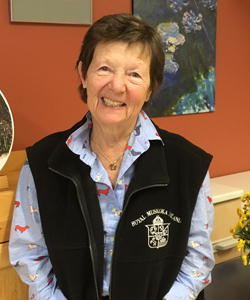From the waiting room to the boardroom: the importance of patient and family advisors

By Amber Daugherty

Betty Power
Betty Power waited more than three hours at St. Michael’s for a CT scan, growing increasingly frustrated as no information was shared about the cause of the delay or when she could expect to be seen. A few months later, she shared her feedback directly with the team responsible for CT scans, but not as a patient – as a patient and family advisor on the hospital’s Medical Imaging quality improvement committee.
“At the first meeting I attended, I shared my story,” she said. “It was one of those examples of getting lost in the cracks and having to wait for so long. It’s that piece – the waiting – that I think gets patients upset. So we talked about how we could improve that.”
The committee meets regularly to identify current issues and brainstorm solutions, and is just one of the many similar committees that exist across our network to focus on improving quality of care, patient safety and experience.
Jennifer Meher, manager of St. Michael’s medical imaging program, said Power’s story is exactly why the committee is needed and, more importantly, why patient and family advisors need to be involved.
“Health-care workers always think we have the solutions – it’s a good quality in some ways because it makes us active in our jobs and we do the best we can, but the downside is that we sometimes forget to listen to the people we’re actually taking care of,” she said. “Hearing from Betty that all she needed for a better experience was someone to come out and tell her that we were running behind is a reminder that we always need to consider our patients’ perspective first.”
Power is one of the more than 160 patient advisors across Providence, St. Joseph’s and St. Michael’s integrated within our teams. Her role is crucial: help the care team working on new projects and initiatives remember who’s at the centre of everything we’re doing: the patient.
“I come out of the meetings and my head is swimming with ideas,” Power said. “I feel very challenged in a positive way to do some education and research on my own to be able to come back with more recommendations.”
“Betty is helping make the work we do more real,” said Meher. “Having her on our team is part of a culture shift – if we want to create the best experience for our patients, we need to hear directly from them what that looks like. We’re grateful for her support so far and so excited to keep working with her.”
Involving more patient and family advisors on our teams was one of our quality improvement goals this year. Learn more about our other quality improvement goals.
About St. Michael’s Hospital
St. Michael’s Hospital provides compassionate care to all who enter its doors. The hospital also provides outstanding medical education to future health care professionals in more than 29 academic disciplines. Critical care and trauma, heart disease, neurosurgery, diabetes, cancer care, care of the homeless and global health are among the Hospital’s recognized areas of expertise. Through the Keenan Research Centre and the Li Ka Shing International Healthcare Education Centre, which make up the Li Ka Shing Knowledge Institute, research and education at St. Michael’s Hospital are recognized and make an impact around the world. Founded in 1892, the hospital is fully affiliated with the University of Toronto.
St. Michael’s Hospital with Providence Healthcare and St. Joseph’s Health Centre now operate under one corporate entity as of August 1, 2017. United, the three organizations serve patients, residents and clients across the full spectrum of care, spanning primary care, secondary community care, tertiary and quaternary care services to post-acute through rehabilitation, palliative care and long-term care, while investing in world-class research and education.
